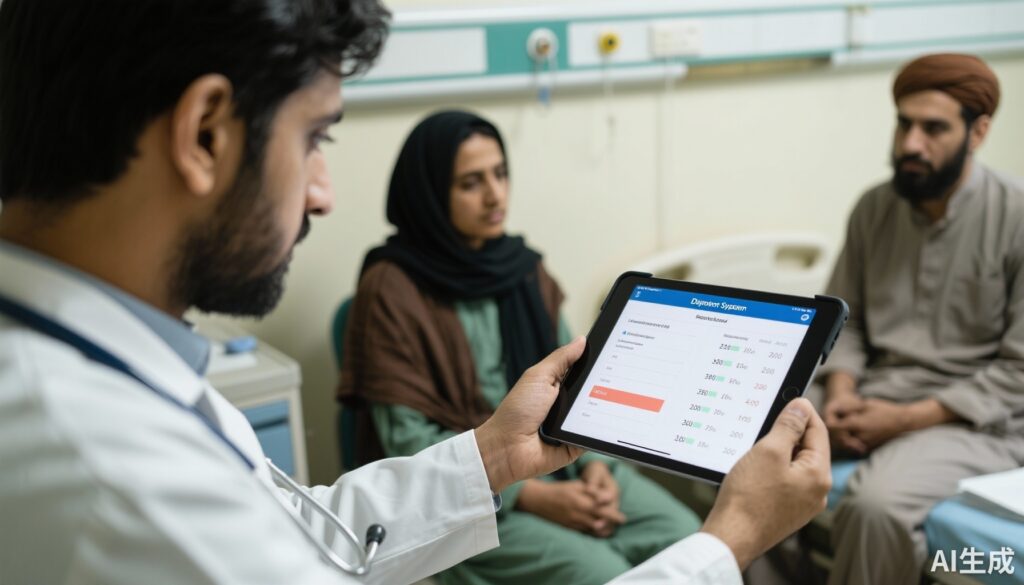Highlight
Measurement-Based Care (MBC) leads to a significantly faster time to response and remission compared to standard care in adults with major depressive disorder (MDD) in Pakistan.
MBC integrates structured symptom and side-effect monitoring to inform antidepressant dose adjustments, using limited pharmacotherapy options (paroxetine or mirtazapine).
Despite no significant differences in response or remission rates at 24 weeks, MBC achieved earlier symptomatic improvement, with a modestly greater reduction in depression severity post-24 weeks.
This trial provides strong evidence supporting MBC’s utility in low- and middle-income countries (LMICs), highlighting the need for further effectiveness and cost-effectiveness research.
Study Background and Disease Burden
Major depressive disorder (MDD) is a leading contributor to global disability, characterized by persistent low mood, anhedonia, and functional impairment. Treatment gaps, poor response to antidepressants, and high relapse rates challenge effective management especially in low- and middle-income countries (LMICs). LMICs frequently face limited access to mental health specialists, scarcity of standardized follow-up, and socio-economic barriers, which adversely impact treatment outcomes.
Measurement-Based Care (MBC) leverages systematic, periodic assessment of depressive symptoms and adverse effects to guide pharmacotherapy decisions. While MBC has been associated with superior clinical outcomes in high-income settings, its effectiveness in LMIC contexts has been insufficiently studied. There is a critical need to evaluate structured care models adaptable to resource-limited settings.
Study Design
This multicenter, randomized, assessor-blinded, parallel-arm clinical trial was conducted across seven cities in Pakistan (Karachi, Lahore, Rawalpindi, Hyderabad, Peshawar, Multan, and Quetta) between September 2022 and January 2024. Adults diagnosed with nonpsychotic MDD were recruited from psychiatric hospitals and primary care centers, reflecting both urban and semi-urban populations.
A total of 154 adults (mean age 34.5 years; 68.2% female) were randomized 1:1 to receive either Measurement-Based Care (MBC) or standard clinical care. Both groups received pharmacotherapy restricted to either paroxetine or mirtazapine, reflecting local prescribing practices and resource availability.
In the MBC arm, participants completed validated instruments—the 16-item Quick Inventory of Depressive Symptomatology-Self-Report (QIDS-SR16) and the Frequency, Intensity, and Burden of Side Effects Rating Scale—at baseline and scheduled visits at weeks 2, 4, 8, 12, and 24. These scores directly informed antidepressant dosing or switching strategies. The standard care group received treatment based on clinical judgment without repeated structured assessments.
Intention-to-treat analyses focused on primary endpoints: time to response (≥50% reduction in 17-item Hamilton Depression Rating Scale [HDRS-17]) and time to remission (HDRS-17 ≤7) within 24 weeks. Secondary endpoints included overall HDRS-17 score changes, adverse effects, and treatment discontinuation rates.
Key Findings
The primary analysis revealed that MBC significantly accelerated depressive symptom resolution compared to standard care. Median time to response in the MBC group was 2 weeks (interquartile range [IQR], 2–4) compared to 4 weeks (IQR, 2–12) in standard care. Likewise, median time to remission was reduced (4 weeks [IQR, 4–8] vs 8 weeks [range, 2 weeks to no remission]).
Despite the earlier improvement, rates of response and remission at week 24 did not significantly differ between groups, indicating that over a longer timeframe, both approaches achieved comparable symptomatic control.
Post week 24, the mean reduction in HDRS-17 scores was modestly but statistically greater in the MBC group (-18.1 points; 95% CI, 16.4–19.6) than standard care (-17.0 points; 95% CI, 15.6–18.5) with a P-value <.001. No notable differences were observed regarding adverse effects or treatment discontinuation, supporting the safety and tolerability of MBC in this population.
These findings underscore the clinical benefit of structured symptom monitoring and data-driven pharmacotherapy adjustments to achieve earlier symptomatic relief in MDD within a resource-constrained healthcare environment.
Expert Commentary
This landmark trial fills a critical evidence gap by demonstrating MBC’s applicability and effectiveness in Pakistan, an LMIC setting with diverse healthcare challenges. The trial design’s strengths include multicenter representation, assessor blinding, standardized psychometric tools, and rigorous intention-to-treat analysis.
However, certain limitations warrant discussion. The exclusive focus on paroxetine and mirtazapine may limit generalizability to other antidepressants. The absence of blinding for treating clinicians could introduce bias in treatment decisions though outcome assessors were blinded. The 24-week follow-up, while sufficient to demonstrate early response differences, did not show sustained outcome divergence, highlighting the need for longer-term studies.
From a mechanistic standpoint, MBC’s iterative symptom and side-effect feedback loop facilitates timely dose optimization and medication switches, critical to overcoming partial or non-response — a frequent barrier in antidepressant care.
Current clinical guidelines increasingly endorse measurement-based approaches due to their patient-centered nature and potential to reduce guesswork in pharmacotherapy titration. This trial corroborates such recommendations under LMIC real-world constraints.
Conclusion
Measurement-Based Care significantly accelerates the time to antidepressant treatment response and remission in adults with major depressive disorder in Pakistan’s low-resource settings. By implementing structured symptom and side-effect monitoring using validated scales, clinicians can make more informed treatment decisions, resulting in earlier clinical improvement.
While long-term response and remission rates ultimately converge with standard care, the expedited symptom relief afforded by MBC may enhance patient quality of life, adherence, and overall treatment satisfaction.
Future research should focus on confirming these findings in broader LMIC populations, evaluating MBC’s cost-effectiveness, and exploring integration strategies within diverse healthcare infrastructures. Expanding antidepressant options and incorporating digital health tools could further optimize MBC’s scalability and impact.
The evidence supports prioritizing measurement-based care models to bridge mental health treatment gaps in under-resourced environments and improve global depression outcomes.
References
1. Husain MI, Nigah Z, Ansari SUH, et al. Measurement-Based Care to Enhance Antidepressant Treatment Outcomes in Major Depressive Disorder: A Randomized Clinical Trial. JAMA Netw Open. 2025;8(9):e2529427. doi:10.1001/jamanetworkopen.2025.29427
2. Rush AJ, Trivedi MH, Wisniewski SR, et al. Acute and longer-term outcomes in depressed outpatients requiring one or several treatment steps: a STAR*D report. Am J Psychiatry. 2006;163(11):1905-1917. doi:10.1176/ajp.2006.163.11.1905
3. Guo T, Xiang YT, Xiao L, et al. Measurement-based care versus standard care for major depression: a randomized controlled trial with blind raters. Am J Psychiatry. 2015;172(10):1004-1013. doi:10.1176/appi.ajp.2015.14101211
4. World Health Organization. Depression and Other Common Mental Disorders Global Health Estimates. Geneva: WHO; 2017.



